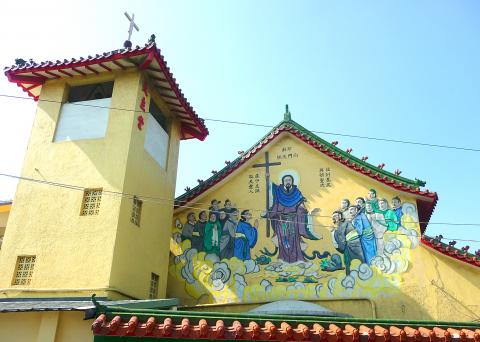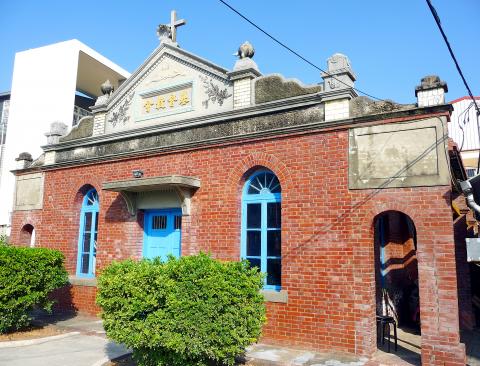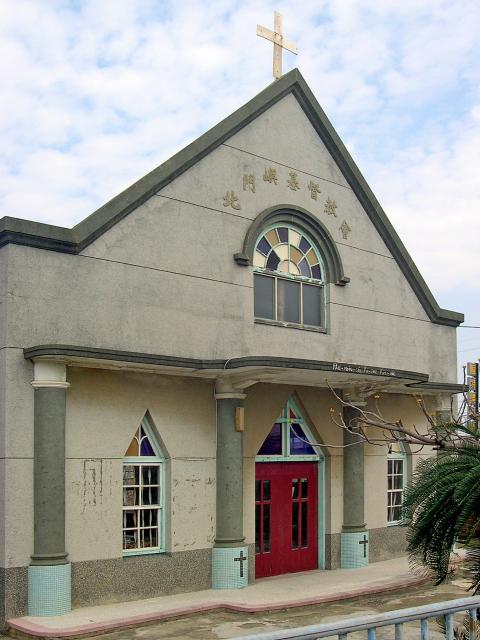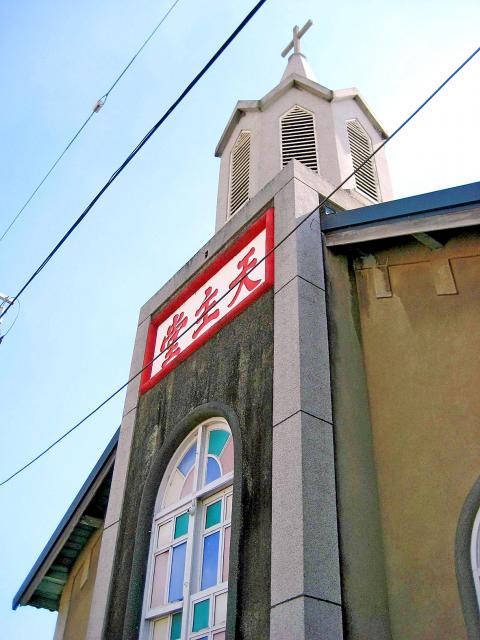The lower stretch of the Bajhang River (八掌) divides Chiayi County from Tainan City, and life on either side of the waterway remains quite traditional. In this corner of the Chianan Plain (嘉南平原), fishing, aquaculture and agriculture are important components of the rural economy
Every village has at least one temple representing popular religion, yet there’s also plenty of evidence to support a conclusion drawn by Pew Research in 2014: After Singapore, Taiwan is the most religiously diverse society in the world. In Western countries, one is unlikely to find a mosque or a Hindu temple in a rural area. In Taiwan, by contrast, there are Christian places of worship everywhere — and no friction, or none worth speaking of, between monotheistic Taiwanese and their polytheistic neighbors.
Beimen District (北門) in Tainan has what some reckon to be the country’s most-visited religious site, Nankunshen Daitian Temple (南鯤鯓代天府). At the same time, Beimen is the location of a museum that celebrates the work of a Christian medical mission.

Photo: Steve Crook
Taiwan Black-foot Disease Socio-Medical Service Memorial Hall (台灣烏腳病醫療紀念館) is next door to the former clinic that local doctor and lay preacher Wang King-ho (王金河, 1916–2014) operated from 1960 to 1986. Wang devoted himself to treating the peculiar local health problem known as black-foot disease (BFD). Victims of this chronic progressive disease, which was caused by drinking well-water contaminated with arsenic, suffered great pain; their feet often turned black, and many had extremities amputated. Now the afflicted areas are supplied with water from elsewhere, BFD is no longer a threat.
The Presbyterian Church with which Wang was affiliated is at 31 Yonglong Borough (永隆), just up the road from the memorial hall at number 27. It’s an elegant building, but less intriguing than another Presbyterian landmark 20km to the northeast.
DONGHOULIAO CHURCH

Photo: Steve Crook
Donghouliao Church (東後寮教會) is in Chiayi County’s Yijhu Township (義竹). If you’re coming from the south, you’ll find it on the right side of Highway 19, a short distance north of the 94km marker. If you’re approaching from the north, look for it on the same side of the road as, and just past, Guangrong Elementary School (光榮國小).
The church was founded in 1917 and grew rapidly. By 1928, about 300 people were attending services. The main attraction here is the redbrick chapel near the main road. Built in 1926 to a simple rectangular design, it lacks a steeple, and is no taller than many of the single-story houses in the village. The buttresses along the sides and at the back were added after the building sustained damage in earthquakes in 1927, 1930 and 1935.
If you stand in front of the old church you’ll see a modern activity center on the left, and behind that the current church. The latter, built in the 1960s, has about three times the capacity of the redbrick hall. According to the Web site of the Presbyterian Church in Taiwan, as of last year the congregation numbered 162, with women outnumbering men.

Photo: Steve Crook
Photos of the facade taken in the 1930s show the English words, “The Christian Church of Togoryo.” These were erased long ago, perhaps because that toponym was a relic of Japanese rule. Inside, above where the altar was once placed, there’s a four-character inscribed tablet. Unlike similar tablets in local temples, this beautiful item isn’t besmirched by soot and grime from incense smoke. From right to left it reads “Christ’s teachings” (基督聖教).
A report in September last year on the Taiwan Church News Network Web site quotes the pastor as saying that, in the past, the Presbyterians reached out to young people, but now that the rural population is dwindling, its most important mission is caring for the elderly.
Southeast Asia-born residents are beginning to join the congregation; many of them have Christian backgrounds, the pastor says, “but previously they were unable to step into the church because of family obstacles. The older generation is now passing, and religious taboos are gradually loosening. It is an opportunity to evangelize these newcomers.”

Photo: Steve Crook
ST. JOSEPH’S CHURCH
Driving south from Donghouliao on Highway 19 brings you to the busiest part of Yijhu. There, at 423-1 Renli Village (仁里), you’ll find St. Joseph’s Church (聖若瑟堂). This Roman Catholic hall of worship was constructed in 1960 to serve a congregation that had formed a few years earlier. During this period, the Catholic church in Taiwan experienced rapid growth, in large part because of an influx of priests, nuns and lay believers from China.
The exterior and interior of St. Joseph’s Church are quite plain, certainly in comparison to the next church on our tour. Taking Highway 19 into Tainan will bring you to Yanshui (鹽水), a town best known for its Beehive Fireworks Festival, an annual event closely tied to popular folk religion.

Photo: Steve Crook
HOLY TRINITY CATHOLIC CHURCH
Holy Trinity Catholic Church (鹽水天主堂) is at 19 Simen Road, close to where you can catch a bus from Yanshui to Budai (布袋) via Yijhu, or to the railway station at Sinying (新營). The pale yellow walls and bell tower aren’t much of a hint as to what can be seen within. However, the roof does somewhat resemble that of a local temple, and the apparel of those shown in the mural of Jesus and his followers is distinctly Chinese.
The interior is nothing short of breathtaking. The longer you linger, the greater your wonderment. On the wall behind the altar, there’s a large illustration inspired by da Vinci’s The Last Supper. In this depiction of Christ and his apostles, each man sports Asian facial features and traditional Chinese clothes. Most of them are bearded like the sages of ancient China, and they sit at a table loaded with chopsticks and plates of steamed buns.

Photo: Steve Crook
In this church’s version of the Feeding of the Multitude, the tree looks very much like those which appear in classical Chinese landscape paintings. There are localized images of the crucifixion, but most striking of all is the dignified individual who looks down over the worshipers from the rear wall. He has a “vast, protruding, bulbous forehead, big ears, long drooping eyebrows, white beard and [a] plump, robe-clad figure.” Those words — written about the Chinese god of longevity, Lao Shouxing (老壽星), by Patricia Bjaaland Welch in her book Chinese Art: A Guide to Motifs and Visual Imagery — perfectly describe this depiction of the Christian deity.
Does any of this deviate too far from the conventions of Western religious art? Not according to Catholic author Angelo Stagnaro. In a May 2017 blog post for the National Catholic Register, he gushes about the church, stressing: “Every aspect of the traditional Taoist temple is replicated, baptized and made Christian all for the greater glory of God.”
Steven Crook has been writing about travel, culture, and business in Taiwan since 1996. Having recently co-authored A Culinary History of Taipei: Beyond Pork and Ponlai, he is now updating Taiwan: The Bradt Travel Guide.

Exceptions to the rule are sometimes revealing. For a brief few years, there was an emerging ideological split between the Democratic Progressive Party (DPP) and Chinese Nationalist Party (KMT) that appeared to be pushing the DPP in a direction that would be considered more liberal, and the KMT more conservative. In the previous column, “The KMT-DPP’s bureaucrat-led developmental state” (Dec. 11, page 12), we examined how Taiwan’s democratic system developed, and how both the two main parties largely accepted a similar consensus on how Taiwan should be run domestically and did not split along the left-right lines more familiar in

As I finally slid into the warm embrace of the hot, clifftop pool, it was a serene moment of reflection. The sound of the river reflected off the cave walls, the white of our camping lights reflected off the dark, shimmering surface of the water, and I reflected on how fortunate I was to be here. After all, the beautiful walk through narrow canyons that had brought us here had been inaccessible for five years — and will be again soon. The day had started at the Huisun Forest Area (惠蓀林場), at the end of Nantou County Route 80, north and east

This month the government ordered a one-year block of Xiaohongshu (小紅書) or Rednote, a Chinese social media platform with more than 3 million users in Taiwan. The government pointed to widespread fraud activity on the platform, along with cybersecurity failures. Officials said that they had reached out to the company and asked it to change. However, they received no response. The pro-China parties, the Chinese Nationalist Party (KMT) and Taiwan People’s Party (TPP), immediately swung into action, denouncing the ban as an attack on free speech. This “free speech” claim was then echoed by the People’s Republic of China (PRC),

Specialty sandwiches loaded with the contents of an entire charcuterie board, overflowing with sauces, creams and all manner of creative add-ons, is perhaps one of the biggest global food trends of this year. From London to New York, lines form down the block for mortadella, burrata, pistachio and more stuffed between slices of fresh sourdough, rye or focaccia. To try the trend in Taipei, Munchies Mafia is for sure the spot — could this be the best sandwich in town? Carlos from Spain and Sergio from Mexico opened this spot just seven months ago. The two met working in the